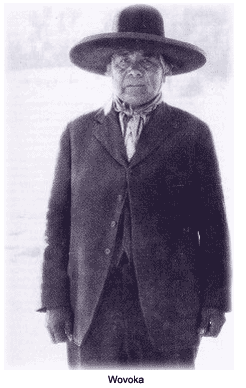 Wovoka, which means wood cutter in the Northern Paiute language, was consumed by the plight of his people and the disparity between them and their oppressors. He sought peace, the return of the buffalo, and the traditional Indian way of life without the white man.
When Wovoka revived* the Ghost Dance, he offered hope to a people that began as dignified and free tribes, but were, in Wovoka's day, demoralized by defeat, subjugation, oppression, and segregation. They had become welfare recipients subsisting on their white masters' handouts.
Wovoka, which means wood cutter in the Northern Paiute language, was consumed by the plight of his people and the disparity between them and their oppressors. He sought peace, the return of the buffalo, and the traditional Indian way of life without the white man.
When Wovoka revived* the Ghost Dance, he offered hope to a people that began as dignified and free tribes, but were, in Wovoka's day, demoralized by defeat, subjugation, oppression, and segregation. They had become welfare recipients subsisting on their white masters' handouts.
Youth and early adulthood
Wovoka was born in 1858, in Western Nevada. He was the son of Tävibo and his wife Teeya.
Wovoka grew up on the David Wilson ranch in Yerington, Nevada. The young man became deeply moved by Native American spirituality as he helped his father, a Paiute Shaman and mystic, with traditional spiritual ceremonies. After his father died, Wovoka moved in with the Wilson family and began to use the name Jack Wilson when dealing with white people.
David Wilson, a devout Christian, imparted to Wovoka a strong Christian education, including theology and Bible stories. Wovoka’s introduction to the Christian faith was Wilson’s brand of Fundamentalism, where prayers were said before every meal and Bible passages read on a daily basis. Itinerant ministers, who held revival meetings, drove that religious indoctrination home. In effect, the youngster had received a double dose of spirituality: from the Christian faith and Paiute shamanism.
Adulthood, marriage, and the dance
As a young adult, Wovoka worked on the ranch as a hired hand. Even as he worked for the Wilsons, he found time to be a shaman. Using “magic” tricks, Wovoka earned a reputation as a potent shaman.
Wovoka married a young Northern Paiute woman who bore the tribal name Tuuma, a word that denotes a woven basket used for cooking pine nuts. Wovoka and Tuuma had several children.
Wovoka entwined and shaped shamanism and Christianity into the structure and principles of the 1890 Ghost Dance. Performing the dance would bring about restoration of native life, complete with the return of ancestors, the buffalo, and peace with the white man. Word of the Ghost Dance spread to other tribes, including the Lakota from the Northern Plains. He began to have visitors who took the dance principles home, then twisted them to serve their own pressing needs. The Lakota dreamed up "bulletproof" Ghost Dance shirts, made of ordinary cloth or deerskin, that played a lamentable part in the Wounded Knee disaster of 1890, when U.S. soldiers opened fire and murdered scores of men, women, and children. Wovoka kept his faith in the Ghost Dance, even though the forerunner of the dance, Wodziwob, had not. He continued to beguile visitors from all over the country until his death. For the remainder of his life, Wovoka supported himself by selling such mystical items as eagle tail feathers. He continued to practice services as a shaman, for which he received local payment. Wovoka died on the Walker River Reservation in Nevada, on September 20, 1932.